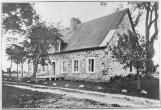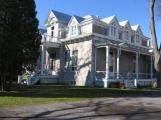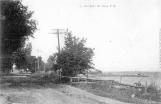14
Second presbytery of Batiscan20th century, before 1922
Batiscan (Quebec), Canada
 Credits:
Credits:Vieux manoirs, vieilles maisons, Commission des monuments historiques de la province de Québec
15
During that period, the land owned by the Parish Council was at the heart of the activities of the parish. The church, the presbytery, the cemetery and the mill were all located on these lands. The first village mill, were the land tenants were obligated to bring their grain to be ground, was located at the centre of the segniory, near the St. Lawrence, and was a hub of activity.
16
Diagram of the siteFrom 17th to 19th century
Batiscan (Quebec), Canada
 Credits:
Credits:Drawing by Berthe - I. Brunelle of Batiscan
17
Given the quick rise in population, the church could no longer welcome its parishioners due to lack of space by 1865. Many accounts tell of people having to sit on overturned buckets or having to stand all through mass. As this situation was unacceptable, the Parish Council decided to build a new church.
It was decided that the new church should be erected closer to the heart of the parish, which had migrated towards the east over the years. A new presbytery would also be built next to the church. To please the parishioners who were unhappy about the new location of the church and thus having to finance the construction of the new presbytery, Wencelas Fréchette promised to take responsibility for the cost of his home. As he was an excellent negotiator, he was offered the old presbytery, the old church, as well as the grounds on which they were located in exchange for his financial implication.
18
St. François-Xavier de Batiscan ChurchEnd of 19th century
Batiscan (Quebec), Canada
 Credits:
Credits:Pinsonneault
19
Present day presbyteryEnd of 19th century
Batiscan (Quebec), Canada
 Credits:
Credits:Batiscan's Historical Society "Batiscan et son Histoire"
20
ECONOMIC LIFE IN BATISCAN
From the beginnings of the colony to the end of the 18th century, agriculture was the means of livelihood in Batiscan. Towards the 1860's, the economy shifted from agricultural to naval. The heart of the village moved near the docks at the mouth of the Batiscan River to foster maritime commerce and naval industry. This economy nevertheless changed with the rise of regional logging activities and the establishment of several sawmills in the Mauricie region. These sawmills were usually small and hired dozens of seasonal workers. Their business activities were of local and international nature.
24
Consequently to England engaging in the Napoleonic wars, an important growth was noted in the purchase orders for wood and vessels. This resulted in the establishment of sawmills and a shipyard on the Batiscan River. The arrival of these fair-sized industries brought a sense of prosperity to the parish.



